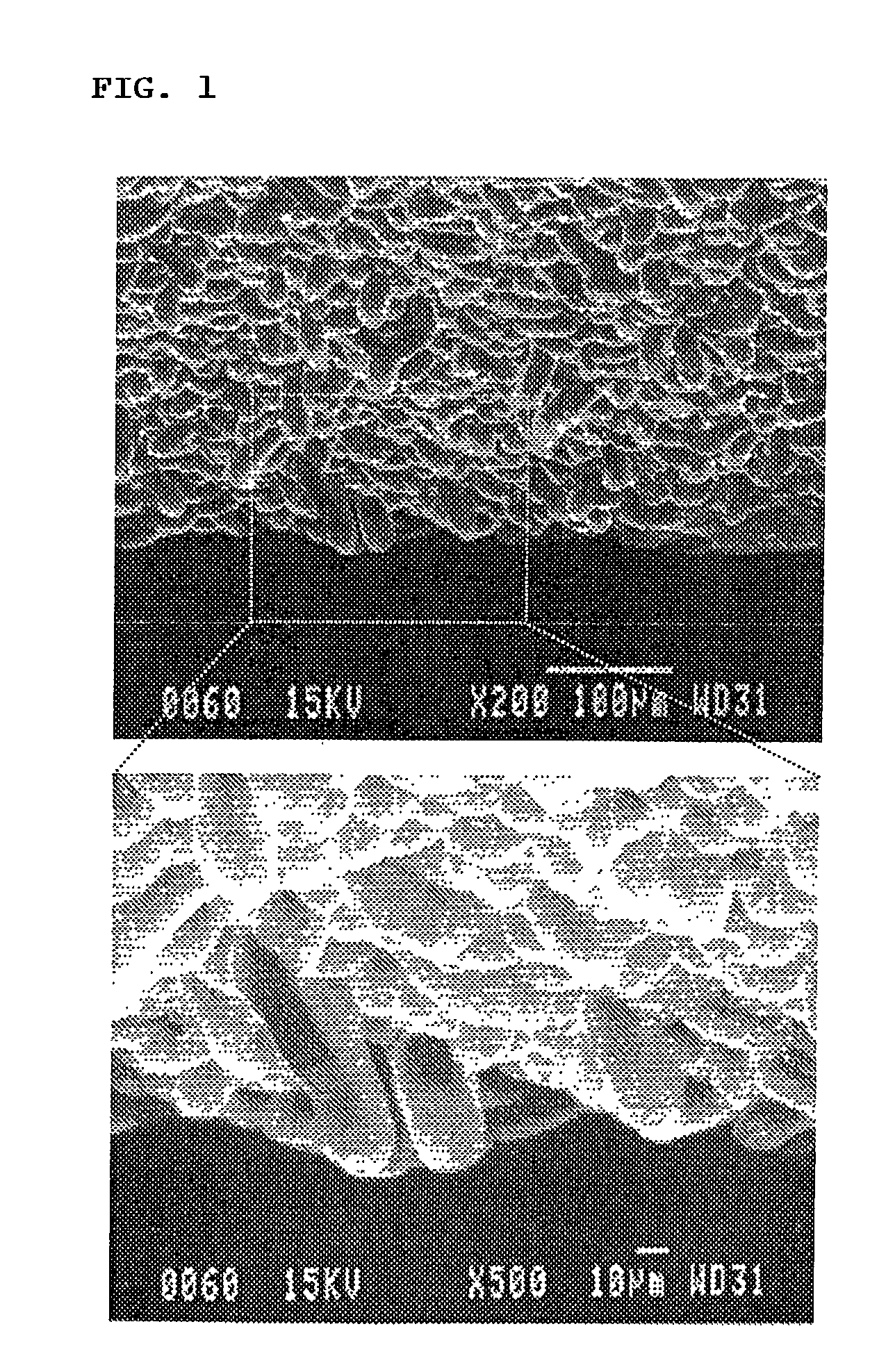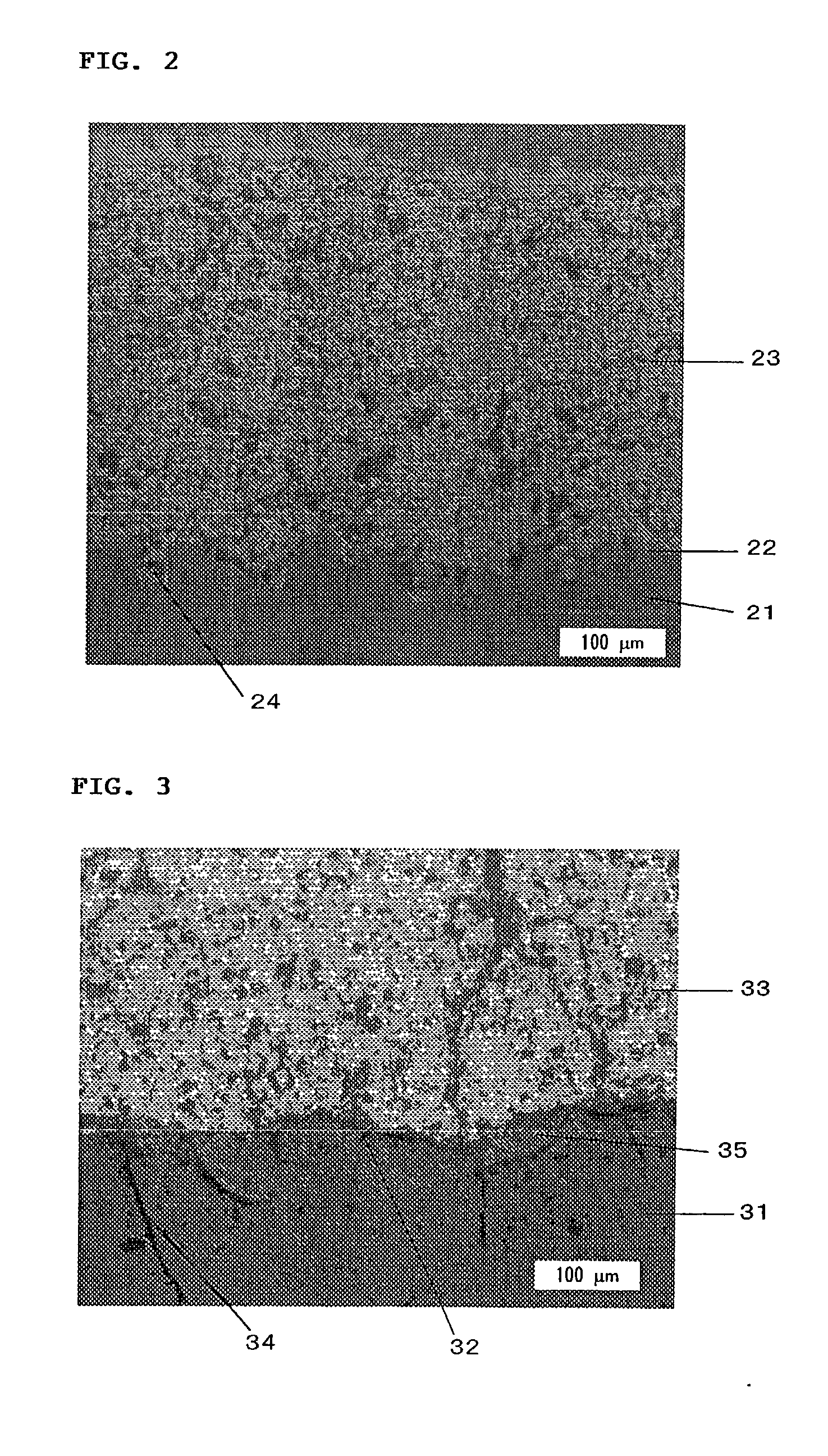Quartz glass parts, ceramic parts and process of producing those
a technology of glass parts and ceramic parts, applied in the directions of film/foil adhesives, transportation and packaging, natural mineral layered products, etc., can solve the problems of dust generation, deterioration of parts, contamination of the interiors of devices and product substrates,
- Summary
- Abstract
- Description
- Claims
- Application Information
AI Technical Summary
Benefits of technology
Problems solved by technology
Method used
Image
Examples
example 2
[0090] An inner surface of a quartz bell-jar 41 was subjected to blast processing at a pressure of 0.5 MPa using white alumina-made grit WA #60, ultrasonically rinsed with pure water, and dried in an oven. Thereafter, an alumina thermal sprayed coating 42 was formed on the inner surface of the quartz bell-jar by plasma thermal spraying in a flow rate of Ar to H.sub.2 of 75 / 25 at a distance between a plasma gun and a substrate of 150 mm. For the plasma spraying was used a spherical alumina granulated powder (purity: 99.99% by weight) having a mean particle size of 50 .mu.m, as prepared by sintering so as to have a relative density of about 95%. A film thickness of the thermal sprayed coating varied depending on the place but was from 0.2 to 0.3 mm. A surface roughness Ra of the thermal sprayed coating was 13 .mu.m. After the plasma spraying, the bell-jar was ultrasonically rinsed with ultrapure water and dried in a clean oven. There was thus completed a quartz bell-jar corresponding ...
example 3
[0091] Quartz glass parts formed with a thermal sprayed coating, corresponding to the first aspect of the present invention, were prepared in the same manner as in Example 2, while using, as a raw material powder, a YSZ power having a mean particle size of 40 .mu.m (partially stabilized zirconia containing 5% by weight of yttria) and spherical granulated particles having a mean particle size of 45 .mu.m, as prepared by mixing alumina (purity: 99.9% by weight) and magnesia (purity: 99.9% by weight) in a ratio of 1 / 1. There were thus obtained quartz glass parts having a film thickness of the thermal sprayed coating of from 0.2 to 0.3 mm and a surface roughness Ra of the thermal sprayed coating of 15 .mu.m and 17 .mu.m, respectively, corresponding to the first aspect of the present invention. The thermal sprayed coating had a relative density measured by the Archimedes' method of 88% and 92%, respectively.
example 4
[0094] Any of the quartz bell-jars of Examples 1, 2 and 3 were free from peeling off of the thermal sprayed coating and were well finished. The quartz bell-jars of Examples 1, 2 and 3 and Comparative Examples 1 and 2 were each used in a pre-cleaning device. In the case of Comparative Example 1 (where no alumina thermal sprayed coating was formed) and Comparative Example 2 (where the surface roughness Ra of the alumina thermal sprayed coating was small), 100 hours after the use, particles caused by peeling off of the film-like adherend were collected in the device. On the other hand, in the case of Examples 1, 2 and 3, even 200 hours after the use, peeled-off particles were not observed, and it was confirmed that the bell-jars of Examples 1, 2 and 3 could be used continuously for a two-fold period of time under the same conditions for use. In the case of Comparative Example 1, not only peeling off of the film-like adherend was observed, but also peeling off and blister of the alumina...
PUM
| Property | Measurement | Unit |
|---|---|---|
| surface roughness | aaaaa | aaaaa |
| surface roughness Ra | aaaaa | aaaaa |
| surface roughness | aaaaa | aaaaa |
Abstract
Description
Claims
Application Information
 Login to View More
Login to View More - R&D
- Intellectual Property
- Life Sciences
- Materials
- Tech Scout
- Unparalleled Data Quality
- Higher Quality Content
- 60% Fewer Hallucinations
Browse by: Latest US Patents, China's latest patents, Technical Efficacy Thesaurus, Application Domain, Technology Topic, Popular Technical Reports.
© 2025 PatSnap. All rights reserved.Legal|Privacy policy|Modern Slavery Act Transparency Statement|Sitemap|About US| Contact US: help@patsnap.com



